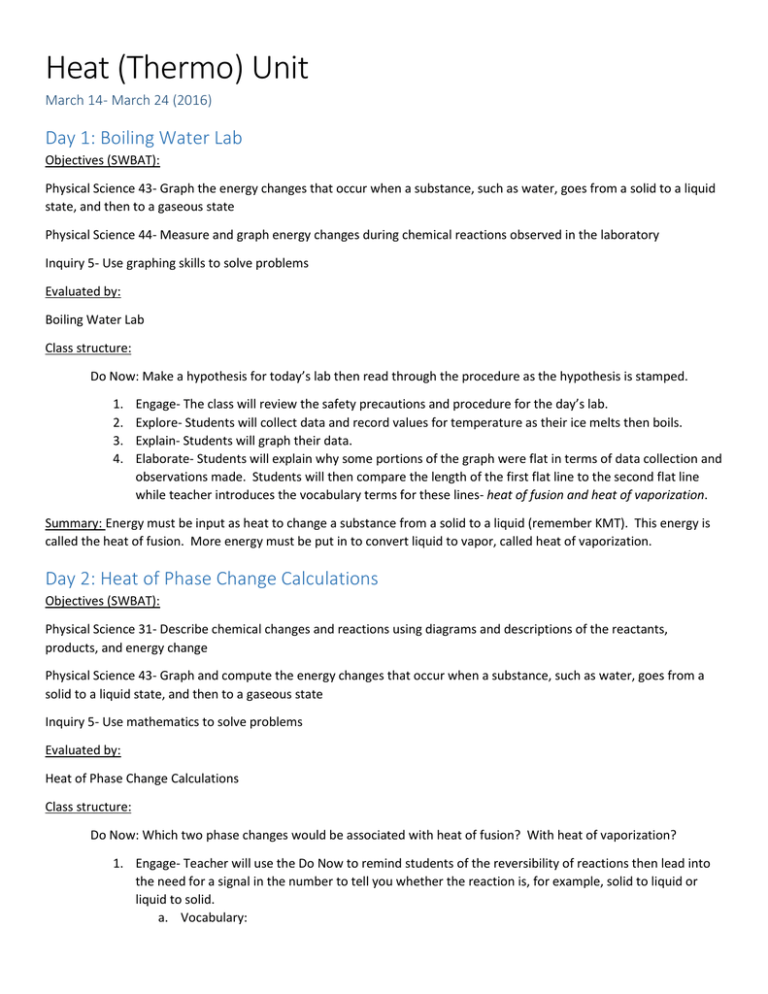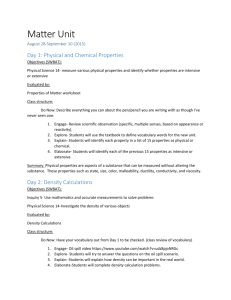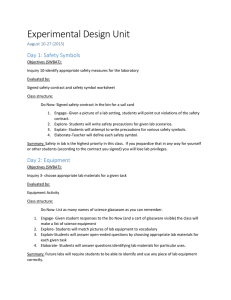Unit-15_LP_Heat
advertisement

Heat (Thermo) Unit March 14- March 24 (2016) Day 1: Boiling Water Lab Objectives (SWBAT): Physical Science 43- Graph the energy changes that occur when a substance, such as water, goes from a solid to a liquid state, and then to a gaseous state Physical Science 44- Measure and graph energy changes during chemical reactions observed in the laboratory Inquiry 5- Use graphing skills to solve problems Evaluated by: Boiling Water Lab Class structure: Do Now: Make a hypothesis for today’s lab then read through the procedure as the hypothesis is stamped. 1. 2. 3. 4. Engage- The class will review the safety precautions and procedure for the day’s lab. Explore- Students will collect data and record values for temperature as their ice melts then boils. Explain- Students will graph their data. Elaborate- Students will explain why some portions of the graph were flat in terms of data collection and observations made. Students will then compare the length of the first flat line to the second flat line while teacher introduces the vocabulary terms for these lines- heat of fusion and heat of vaporization. Summary: Energy must be input as heat to change a substance from a solid to a liquid (remember KMT). This energy is called the heat of fusion. More energy must be put in to convert liquid to vapor, called heat of vaporization. Day 2: Heat of Phase Change Calculations Objectives (SWBAT): Physical Science 31- Describe chemical changes and reactions using diagrams and descriptions of the reactants, products, and energy change Physical Science 43- Graph and compute the energy changes that occur when a substance, such as water, goes from a solid to a liquid state, and then to a gaseous state Inquiry 5- Use mathematics to solve problems Evaluated by: Heat of Phase Change Calculations Class structure: Do Now: Which two phase changes would be associated with heat of fusion? With heat of vaporization? 1. Engage- Teacher will use the Do Now to remind students of the reversibility of reactions then lead into the need for a signal in the number to tell you whether the reaction is, for example, solid to liquid or liquid to solid. a. Vocabulary: i. endothermic- heat must be put in/ absorbed for the reaction or phase change to happen, has a (+) ΔH value, acts as a reactant in the equation (look back at Le Chatelier worksheet to identify the endothermic reaction) ii. exothermic- heat must be taken out/released for the reaction or phase change to happen, has a (-) ΔH value, acts as a product in the equation (look back at Le Chatelier worksheet to identify the endothermic reaction) 2. Explore- Students will look back at the Le Chatelier worksheet to identify two two reactions as endo or exothermic then practice identifying endo and exothermic reactions through observation on the heat transfer worksheet. 3. Explain- Students will explain their endo/exothermic identifications using explanations of heat flow then explain vocabulary terms- latent heat and heat of fusion vs heat of vaporization based on their lab experience from Day 1. 4. Elaborate- Students will calculate the amount of energy transferred during a phase change and apply the correct sign to the number. Summary: Phase changes require and input of energy (heat as a reactant) or release of energy (heat as a product). This heat can be calculated using the substance’s constant multiplied by its mass. The heavier the substance, the more energy required for a phase change. Day 3: Heat of Temperature Change Calculations Objectives (SWBAT): Physical Science 30- Solve problems involving heat flow and temperature changes by using known values of specific heat and latent heat of phase change Inquiry 5- Use mathematics to solve problems Evaluated by: Heat of Temperature Change Calculations Class structure: Do Now: Why does a transfer of energy result in a temperature change (hint: what does it do to the particles/what is the definition of temperature)? 1. Engage- Teacher will draw a heating curve on the board and students will come up to the board to label all phases, phase changes, heat of fusion, heat of vaporization, and when the Q=ΔH*m equation can be used. Then, the teacher will point out that only on the sloped lines (temperature changes) do we not have an equation and give the equation (Q=C*m*ΔT). 2. Explore- Students will calculate the heat needed to raise the temperature of various substances. 3. Explain- Students will show all work. 4. Elaborate- Students will solve two and three part problems- phase and temperature changes- and show all work. Summary: Raising the temperature of a substance required increasing the kinetic energy of the particles. This energy comes from an input of heat. The amount of heat needed depends on the material (each has a specific heat constant), amount, and the temperature difference needed. Day 4: Heating Curve Mini Quiz and Calorimetry Calculations Objectives (SWBAT): Physical Science 31- Describe chemical changes and reactions using diagrams and descriptions of the reactants, products, and energy change Physical Science 30- Solve problems involving heat flow and temperature changes by using known values of specific heat and latent heat of phase change Inquiry 5- Use mathematics to solve problems Evaluated by: -Heating Curve Mini Quiz -Calorimetry Prelab Class structure: Do Now: Clear your desks for the Heating Curve Mini Quiz 1. Engage- Students will review the two equations with a practice problem: Calculate the heat needed to raise 50g of water from 30°C to the boiling point, then boil it? Teacher will introduce the idea that heat of a temperature change could be used for endo and exothermic chemical reactions. 2. Explore- Students will read p. 562 and 563 in the textbook about coffee cup and bomb calorimeters. 3. Explain- Students will describe the two types of calorimeters, filling in the notes sheet. 4. Elaborate- Students will decipher calorimetry word problems to calculate the heat transfer in reactions. Summary: Substances in a chemical reaction have their bonds broken (releasing energy) and form new bonds (using energy). The extra heat released or additional heat needed is called the enthalpy or heat of reaction and can be measured using calorimetry devices. Day 5: Cheeto Lab Objectives (SWBAT): Physical Science 2- Differentiate between accuracy and precision and evaluate percent error Physical Science 44- Measure energy changes during chemical reactions observed in the laboratory Inquiry 5- Use mathematics to solve problems Inquiry 4- Conduct an investigation that includes multiple trials and record, organize, and display data appropriately Evaluated by: Cheeto Lab Class structure: Do Now: If a food has a high number of calories what does this mean for the body of the person consuming it? 1. Engage- The class will review safety precautions and general procedures for the day’s lab then groups will check their members for safety compliance. 2. Explore- Students will burn Cheetos and record data and observations for each trial. 3. Explain- Students will calculate the heat released by the burning cheeto, use this to determine the number of calories in a serving size, then compare their answer to the manufacturer’s data. 4. Elaborate- Students will offer possible sources of error for the data using the notes from day 4 for assistance. Summary: Bomb calorimetry, as used in today’s lab to determine the number of calories in a snack, is only for combustion reactions. In this type of calorimetry, the heat released when an object burns is transferred to another medium, water, so that the measurement of temperature change is easier. Day 6: ΔH on a Potential Energy Graph and in Calculations Objectives (SWBAT): Physical Science 31- Describe chemical changes and reactions using diagrams and descriptions of the reactants, products, and energy change Physical Science 30- Solve problems involving heat flow by using known values of heat of formation Inquiry 5- Use mathematics and graphing skills to solve problems Evaluated by: Heat of Reaction Calculations Class structure: Do Now: Answer the first four questions on the day’s worksheet. 1. Engage- Teacher will introduce the term heat of reaction as the difference in energy between reactants and products (Q5) and show how this definition and the graph can be used to determine whether a reaction is endo or exothermic (Q6). 2. Explore- Students will finish the rest of the graphing questions with an unlabeled graph. 3. Explain- Teacher will show how this can be calculated without a graph but with heat of formation data. 4. Elaborate- Students will calculate the heat of reaction for various problems using heat of formation data while showing all work. Summary: Graphing information is a big part of science. This is something that is tested on the ACT, PLAN, exams, and regular tests. Be able to read and create a reaction progress diagram (potential energy graph). The most important part is locating the reactants and products. Then, the enthalpy (heat) of reaction can be calculated as energy of the products – energy of reactants. Day 7: Hess’ Law Practice Objectives (SWBAT): Physical Science 31- Describe chemical changes and reactions using diagrams and descriptions of the reactants, products, and energy change Physical Science 30- Solve problems involving heat flow by using Hess’ Law Inquiry 5- Use mathematics to solve problems Evaluated by: Hess’ Law Practice Class structure: Do Now: What is the heat of reaction for the equation below? 2 H2 (g) + O2 (g) 2 H2O (g) 1. Engage- Teacher will explain Hess’ Law in terms of puzzle and complete 2-3 problems with students. 2. Explore- Students will complete the remaining Hess’ Law problems. 3. Explain- Students will show all work mathematically and with notes out to the side of each equation. 4. Elaborate- Students will complete the test review for further practice. Summary: In a multistep reaction, all component steps are added together for the total heat of reaction. This process is called Hess’ Law. Day 8: Review for Heat Test Objectives (SWBAT): Inquiry 5- Use mathematics and graphing skills to solve problems Physical Science 2- Differentiate between accuracy and precision and evaluate percent error Physical Science 30- Solve problems involving heat flow by using Hess’ Law, known values of heat of formation, or known values of specific heat and latent heat of phase change Physical Science 31- Describe chemical changes and reactions using diagrams and descriptions of the reactants, products, and energy change Physical Science 43- Graph and compute the energy changes that occur when a substance, such as water, goes from a solid to a liquid state, and then to a gaseous state Physical Science 44- Measure energy changes during chemical reactions observed in the laboratory Evaluated by: Review for Heat Test Class structure: Do Now: Organize your binder for tomorrow’s check. 1. 2. 3. 4. Engage- Teacher will review the list of study topics on the board with student suggestions. Explore- Teacher will discuss the answers to the test review. Explain- Teacher will show all work during the discussion of the review questions. Elaborate- Teacher will also review vocabulary and test layout. Summary: This test is over chapter 17 if further assistance is needed. Be sure to come prepared tomorrow. We are nearing the end but we are not quite there yet. Day 9: Heat Test Objectives (SWBAT): Demonstrate at least 67 % proficiency on the standards of this unit Evaluated by: Test- Heat Class structure: Do Now: Take out a calculator and something to write with, open your binder to the table of contents and place it on the back bench, move your bags to the A/C, and clear your calculator RAM TEST Summary: There are only 7 more weeks of school. One week is finals, one is review, so only five more of new material. Work to solidify this material in your head as we go so that you will not have to study it 6 weeks from now to prepare. Testing Preparation GLE Objective Day(s) Addressed Inquiry 5 Utilize mathematics, organizational tools, and graphing skills to solve problems 1-8 Physical Science 2 Differentiate between accuracy and precision and evaluate percent error 5 Physical Science 30 Solve problems involving heat flow by using Hess’ Law, known values of heat of formation, or known values of specific heat and latent heat of phase change 3, 4, 6, 7 Physical Science 31 Describe chemical changes and reactions using diagrams and descriptions of the reactants, products, and energy change 2, 4, 6, 7 Physical Science 43 Physical Science 44 Graph and compute the energy changes that occur when a substance, such as water, goes from a solid to a liquid state, and then to a gaseous state Measure energy changes during chemical reactions observed in the laboratory 1, 2 1, 5 Vocabulary Latent Heat Exothermic Heat of Reaction Heat of Fusion Calorimetry Heat of Formation Heat of Vaporization Bomb Calorimeter Hess’ Law Endothermic Coffee Cup Calorimeter Equations Q= ΔH*m Q= C*m*ΔT Assessment Design Basic: 6 Questions ΔHrxn= ΔHf (products)- ΔHf (reactants) Standard: 12 Questions % error = actual/theoretical *100 Expanded: 6 Questions Essential Skills and Learning Objectives Type of Question (MC, CR, P) Basic (Remember & Understand) Standard (Apply & Analyze) Expanded (Evaluate & Create) Solve heat of reaction problems using Hess’ Law or known values of heat of formation MC/CR 1 MC 1 CR 1 MC 2 CR 1 CR Graph and compute the energy changes that occur when a substance, such as water, goes from a solid to a liquid state, and then to a gaseous state MC/CR 2 MC 1 MC 5 CR 1 MC 3 CR Describe chemical changes and reactions using diagrams and descriptions of the reactants, products, and energy change MC/CR 1 MC 1 CR 1 MC 2 CR 1 CR






